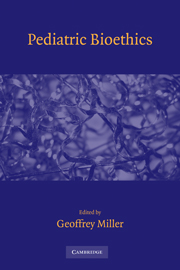Crossref Citations
This Book has been
cited by the following publications. This list is generated based on data provided by Crossref.
2010.
Books of Critical Interest.
Critical Inquiry,
Vol. 36,
Issue. 4,
p.
807.
Miller, Geoffrey
2011.
Clinical Ethics in Pediatrics.
p.
118.
Graf, William D
Miller, Geoffrey
and
Nagel, Saskia K
2014.
Addressing the problem of ADHD medication as neuroenhancements.
Expert Review of Neurotherapeutics,
Vol. 14,
Issue. 5,
p.
569.
Sen, Rajeev D.
Lee, Amy
Browd, Samuel R.
Ellenbogen, Richard G.
and
Hauptman, Jason S.
2021.
Issues of consent and assent in pediatric neurosurgery.
Child's Nervous System,
Vol. 37,
Issue. 1,
p.
33.
Carnevale, Franco A.
Giannini, Alberto
Bonaldi, Amabile
Bravi, Elena
Cecchi, Costanza
Pettenazzo, Andrea
Amigoni, Angela
Pulitanò, Silvia Maria Modesta
Tosin, Chiara
and
Biban, Paolo
2021.
Life-sustaining treatment decisions in pediatric intensive care: an Italian survey on ethical concerns.
Italian Journal of Pediatrics,
Vol. 47,
Issue. 1,
Siedlikowski, Sophia
Van Praagh, Shauna
Shevell, Meaghan
and
Carnevale, Franco A.
2022.
Agency in everyday life: An ethnography of the moral experiences of children and youth.
Children & Society,
Vol. 36,
Issue. 4,
p.
661.
Wang, Yi Wen
Carnevale, Franco A.
Chougui, Khadidja
and
Tsimicalis, Argerie
2023.
How Children's participation ought to be practiced: A preliminary ethical framework to optimise the participation of children with osteogenesis imperfecta in health care.
Journal of Clinical Nursing,
Vol. 32,
Issue. 11-12,
p.
2773.





